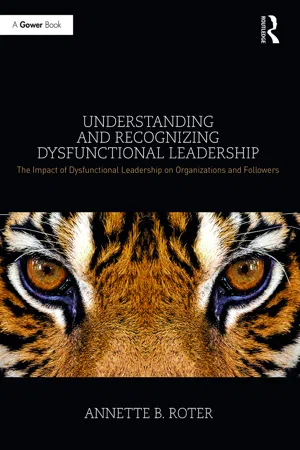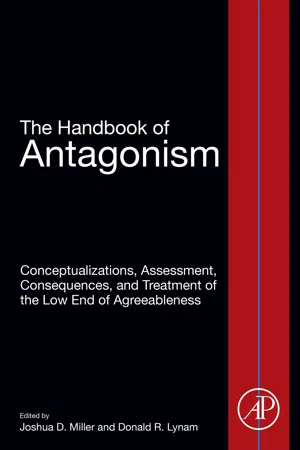Dark Triad
The Dark Triad refers to a set of three personality traits: narcissism, Machiavellianism, and psychopathy. In a business context, individuals with these traits may exhibit manipulative, self-centered, and callous behavior, potentially leading to unethical or harmful actions. These traits can impact workplace dynamics, decision-making, and relationships with colleagues and clients.
7 Key excerpts on "Dark Triad"
- eBook - ePub
The Dark Triad of Personality
Narcissism, Machiavellianism, and Psychopathy in Everyday Life
- Minna Lyons(Author)
- 2019(Publication Date)
- Academic Press(Publisher)
...388). With these three portrayals, LeBreton and colleagues succinctly described the key features of Machiavellianism, narcissism, and psychopathy, evoking a somewhat accurate image of Dark Triad characters that loom at large in workplaces. The Dark Triad has received considerable interest in the fields of occupational, business, and organizational psychology. It is perhaps of no surprise, as cold, callous manipulation can have drastic implications not only for individual well-being at work, but also for the overall workplace functioning, sometimes affecting whole societies and global economies. Indeed, some have suggested that the global financial meltdown in 2008 was caused by immoral, greedy psychopaths employed in high positions in financial corporations (Boddy, 2011). Due to their attraction to power and status (Lee et al., 2013), high Dark Triad individuals are expected to be drawn to occupational fields where they can achieve these goals. Further, the Dark Triad is related to materialism, consumerism, and placing more importance on money than on humanistic values (Lee et al., 2013), which could lead to greed and selfishness in their professional lives. Workplace behaviors of those high in the Dark Triad are often geared toward maximizing their own incomes at the cost of the well-being of others. The Dark Triad is not only associated with the fields of study and work that individuals are attracted to, but it also has an influence on behavior at work as an employee. People at the higher end of the continuum may exhibit counterproductive work behaviors (CWBs), such as stealing from work, being late or absent, or bullying coworkers. These behaviors can be detrimental to work colleagues, teamwork dynamics, as well as to the workplace as a whole. On the other hand, depending on the context, Dark Triad traits might be beneficial as well...
- eBook - ePub
Understanding and Recognizing Dysfunctional Leadership
The Impact of Dysfunctional Leadership on Organizations and Followers
- Annette B. Roter(Author)
- 2017(Publication Date)
- Routledge(Publisher)
...p.71 Part II The Dark Triad p.73 Chapter 5 The Dark Triad Introduction The Dark Triad is a topic in psychology that centers on three personality types, which include narcissism, psychopathy and Machiavellianism. Narcissism is focused on feelings of grandiosity, dominance and superiority as defined by Paulhus and Williams in 2002. Psychopathy features traits of impulsive behavior, thrill seeking, low empathy and low anxiety (Paulhus & Williams, 2002), while Machiavellianism is focused on the manipulation of others (Stead & Fekken, 2014). These three personality types are the most widely studied of all the dysfunctional leadership traits. Research has found that individuals who possess these traits share tendencies to be callous, selfish and spiteful in their dealings with others. Another component of these three constructs is that these individuals thrive in environments that are chaotic and lack structure, and cultures that do not have clear expectations or accountability. These personality types will exploit these types of environments to their advantage. While the three personalities are interconnected with each other and share several themes, they do manifest differently and produce different patterns. Where they intersect is in the areas of low agreeableness, impulsive behaviors and the use of interpersonal manipulation. All three characteristics entail characteristics of self-promotion, emotional detachment and aggressiveness. While the three constructs are very distinct, we find overlaps between Machiavellianism and psychopathy, narcissism and psychopathy, and Machiavellianism and narcissism. It is important to distinguish them from each other because of their uniqueness. The following provides behavioral insights into each of the three personality types that make up the Dark Triad. Table 5.1 Dark Triad traits (Paulhus & Williams, 2002) p.74 Leaders who possess these behaviors demonstrate various traits...
- (Author)
- 2020(Publication Date)
- Wiley(Publisher)
...Dark Triad Rachel A. Plouffe, Claire A. Wilson, and Martin M. Smith University of Western Ontario Overview The Dark Triad refers to three socially aversive traits: psychopathy, narcissism, and Machiavellianism. While psychopathy, narcissism, and Machiavellianism have meaningful factor‐specific variance, they also overlap considerably. Specifically, each of the three Dark Triad traits encompasses a tendency to be callous, manipulative, and low in honsesty‐humility. Traditionally, researchers studied psychopathy and narcissism in clinical populations. However, psychopathy and narcissism have recently been reconceptualized as subclinical traits applicable to the general population. Subclinical psychopathy refers to the dispositional tendency to be impulsive, thrill‐seeking, erratic, and show a consistent lack of anxiety and empathy. Subclinical narcissism refers to the dispositional tendency to seek attention, fantasize of unlimited power, and possess a grandiose sense of entitlement. Finally, Machiavellianism refers to the dispositional tendency to be deceptive, manipulative, and cynical of human nature. The importance of research pertaining to the Dark Triad is substantiated by the Dark Triad’s ability to predict a number of important outcome variables (e.g. preferences for short‐term mating strategies, desire for power, academic dishonesty, engagement in risk‐taking behaviors, and sensation seeking). However, whether the Dark Triad consists of independent traits or a single unified construct is debated. Those who favor the “unification perspective” contend that due to psychopathy, narcissism, and Machiavellianism’s overlap, all three traits fall into the same interpersonal circumplex defined by high agency and low communion...
- eBook - ePub
Machiavellianism
The Psychology of Manipulation
- Tamás Bereczkei(Author)
- 2017(Publication Date)
- Routledge(Publisher)
...The other component is manipulation closely related to lying, derogating others and, too often, remorseless self seeking. When both features are embodied in one individual, it results in a “dark personality”. Beyond these common features, however, all three members of the Dark Triad possess specific traits that are built on the basic structure. Machiavellians are primarily characterised by strategic planning, psychopaths by extreme antisociality, and narcissists by an egocentric outlook on life. I think Machiavellianism, on the one hand, has basic traits in common with other members of Dark Triad. On the other hand, it also shows specific or typical features such as a rational mode of thinking, flexible decision-making, and cost/benefit calculation concerning behavioural output. From this perspective, the Dark Triad concept has in my view a rather poor explanatory power. It does not provide a distinct and unified dimension of personality which may serve to predict specific forms of human behaviour. On the contrary, it represents a loose structure of the three actually existing components but does not constitute a unique and separate personality trait. The Dark Triad is mostly useful for the purposes of description and categorisation insofar as it provides a framework in which the major features of human malevolence and evil may be integrated. However, this is only a wide and weakly integrated conceptual framework which may by no means replace the explanations about Machiavellianism, psychopathy and narcissism as distinct entities....
- eBook - ePub
Corporate Psychopathy
Investigating Destructive Personalities in the Workplace
- Katarina Fritzon, Nathan Brooks, Simon Croom(Authors)
- 2019(Publication Date)
- Palgrave Macmillan(Publisher)
...© The Author(s) 2020 K. Fritzon et al. Corporate Psychopathy https://doi.org/10.1007/978-3-030-27188-6_8 Begin Abstract 8. The Development of a Measure of Dark Triad Traits in a Corporate Sample Katarina Fritzon 1 (1) Bond University, Robina, QLD, Australia Katarina Fritzon Email: [email protected] Keywords Corporate Personality Inventory-Revised Psychopathy Dark Triad Assessment Personality End Abstract The Dark Triad While interest in the manifestation of psychopathy in the workplace remains particularly acute (e.g. a 2nd edition of Babiak and Hare’s Snakes in Suits will be published in late 2019), most of the recent research into personality predictors of negative workplace outcomes has included psychopathy alongside Narcissism and Machiavellianism, known as the Dark Triad (Paulhus & Williams, 2002). Unlike the literature on psychopathy and narcissism, the empirical research on Machiavellianism has primarily been conducted in the field of social and organisational psychology, due to findings of links between this trait and authoritarianism and other socio-political outcomes (Christie & Geis, 1970 ; Vize, Lynam, Collison, & Miller, 2018). Much of the research on the Dark Triad and occupational outcomes has involved the use of instruments that assess the components separately, most commonly the SRP-III (Paulhus, Neumann, & Hare, 2016), the NPI (Raskin & Hall, 1979) and the Mach-IV (Christie & Geis, 1970). More recently, two measures have been developed that contain all three Dark Triad constructs: the Dirty Dozen (Jonason & Webster, 2010) and the Short Dark Triad (SD3; Jones & Paulhus, 2014)...
- Seth M. Spain(Author)
- 2019(Publication Date)
- Academic Press(Publisher)
...In a qualitative study, narcissists were found to exasperate and abuse their negotiating partners, antagonized the negotiation partner rather than gathering information, and adopted an intransigent stance rather than attempting to compromise or seek common ground (Greenhalgh & Gilkey, 1997). Further, narcissists show little empathy in negotiations and argue only from their own interests. All three components of the Dark Triad were associated with willingness to use unethical tactics in negotiations when the negotiation was merely hypothetical; however, they were not noticeably more likely to actually employ unethical tactics in when the negotiation was real and face to face (Wu, 2010). Similarly, a study investigating the role of the Dark Triad as an antecedent of influence tactics (Jonason, Slomski, & Partyka, 2012) found that both Psychopaths and Machiavellians were more likely to use hard tactics, like threats or attempts at manipulation, while Machiavellians and Narcissists were more likely to use soft tactics, like ingratiation, offering to exchange a favor, or compromise. Psychopaths seemed to favor threats, Machiavellians tended to prefer manipulation, and narcissists try to use their appearance and charm to influence others. A Taxonomy of Dark Personality Traits A major lacuna in the study of the dark side of personality is the lack of a generally accepted overarching taxonomy of dark personality characteristics. Most work thus far is focused on either the Dark Triad or the DSM-IV personality disorders. Neither of these approaches is particularly edifying—they are essentially descriptions of typically toxic/aberrant behavioral patterns and may not reasonably reflect the deep structure or processes that drive dark side behavior, such as the implicit motives or defense mechanisms underlying these behaviors (cf., James & LeBreton, 2010, 2012 ; Wood, Lowman, et al., 2017)...
- eBook - ePub
The Handbook of Antagonism
Conceptualizations, Assessment, Consequences, and Treatment of the Low End of Agreeableness
- Joshua W. Miller, Donald Lynam(Authors)
- 2019(Publication Date)
- Academic Press(Publisher)
...17 Antagonism in the Dark Triad Colin E. Vize ⁎ ; Joshua D. Miller † ; Donald R. Lynam ⁎ ⁎ Department of Psychological Sciences, Purdue University, West Lafayette, IN, United States † Department of Psychology, University of Georgia, Athens, GA, United States Abstract Interest in the Dark Triad (DT), which consists of narcissism, psychopathy, and Machiavellianism, has steadily grown since the introduction of the DT in 2002. One research question that has garnered significant attention relates to what constitutes the common core of the DT constructs. Multiple hypotheses have been offered and these hypotheses tend to focus on antagonism and/or specific antagonism-related traits. The present chapter reviews research that has sought to explicate the core of the DT, and we highlight the possibility that particular methodological approaches may lead to differing conclusions about which traits and behaviors best account for the overlap among the DT constructs. These points notwithstanding, the best available data suggest that specific traits related to (low) honesty and (low) modesty constitute the core of the DT. However, additional work is needed to adequately test leading hypotheses against one another regarding what traits and behaviors can best account for the overlap among the DT constructs. Keywords Dark Triad; Antagonism; Core; Honesty-humility; Narcissism; Psychopathy; Machiavellianism The Dark Triad (DT) is a collection of three interrelated, malevolent personality constructs: narcissism, psychopathy, and Machiavellianism (Paulhus & Williams, 2002). 1 Though DT research focuses on the simultaneous assessment of the DT constructs, each DT construct has its own independent literature base. Narcissism has a robust literature in both social and clinical research domains and is represented by Narcissistic Personality Disorder (NPD) within the American Psychiatric Association's Diagnostic and Statistical Manual of Mental Disorders (DSM-5; APA, 2013)...






